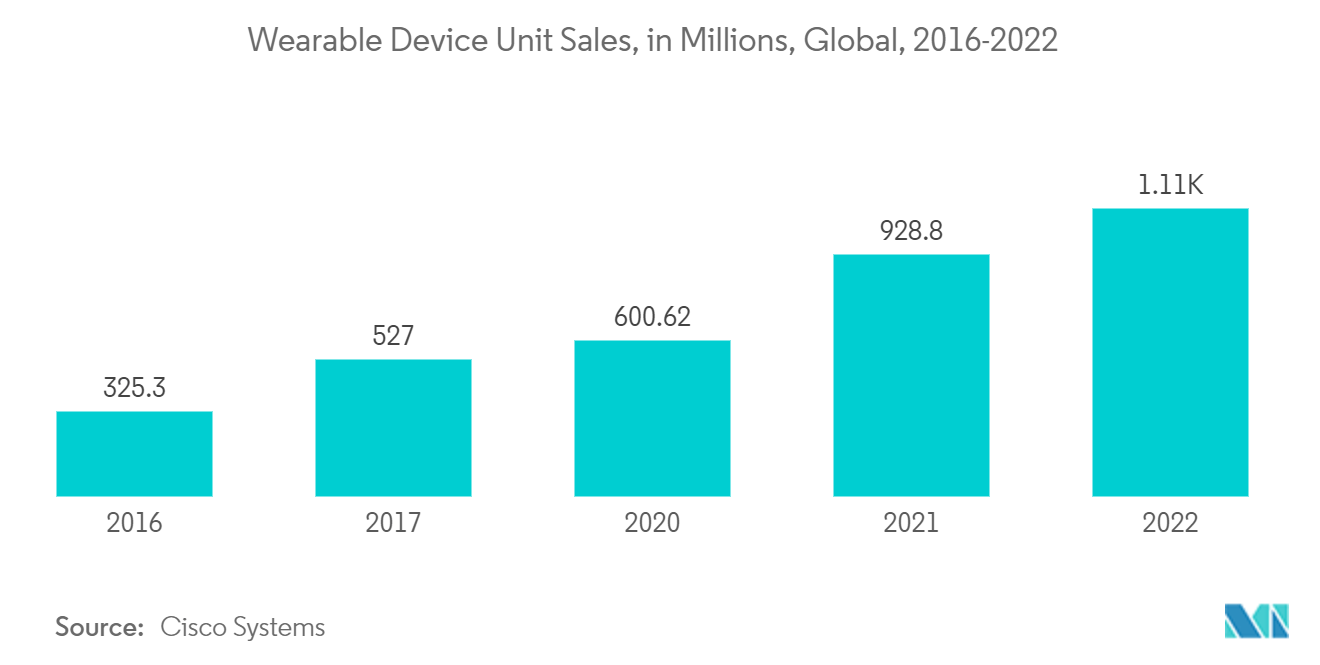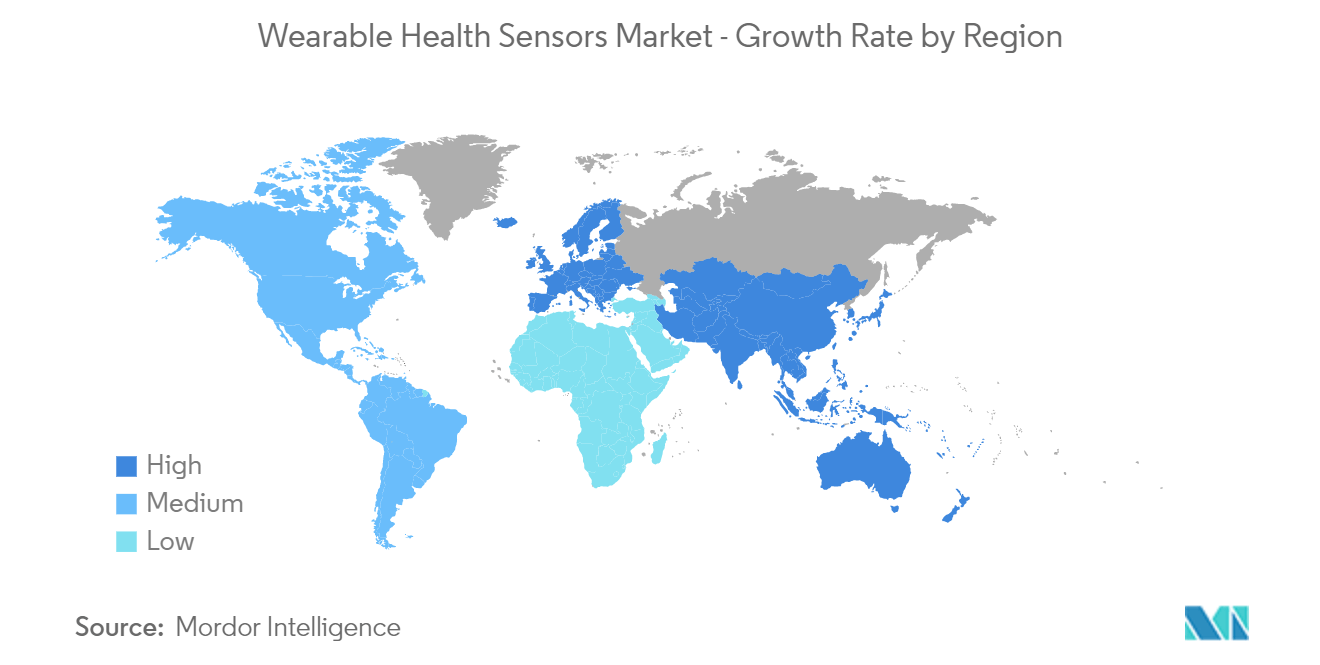Market Trends of Wearable Health Sensors Industry
This section covers the major market trends shaping the Wearable Health Sensors Market according to our research experts:
Healthcare Industry Holds a Dominant Share in Wearable Health Sensors Market
- The increased level of awareness concerning healthcare has created an emerging need for smart sensor technologies and monitoring devices that are able to sense and provide feedback to users about their health status for increased safety. Miniaturization of health sensors will lead to significant benefits in their application since smaller versions of sensors are more flexible, and they can be embedded in a variety of devices to obtain real-time information.
- For instance, in May 2022, MovanoInc., a medical technology start-up, started using radiofrequency technology to develop a patented system-on-chip (SoC) platform for a range of sensors to be incorporated into future medical wearables. The company has started the beta testing of a prototype that will be able to perform blood and glucose sensing.
- Further, various healthcare monitoring systems use different types of sensors developed to monitor specific body parameters of the patient continuously. Different biosensors available to measure heart rate, body oxygen level, and temperature are attached to the Arduino Nano board, and recorded signals are sent to the server using Node MCU ESP8266 wireless communication.
- For instance, in August 2021, Abbott reported data from the GUIDE-HF clinical trial, where its CardioMEMSHF System reduced mortality in New York Heart Association (NYHA) Class II, III, and IV heart failure patients. A small implantable sensor, CardioMEMS, is designed to measure and track pulmonary artery pressure and heart rate wirelessly. These pressure changes suggest deteriorating heart failure even before patients feel symptoms.
- Moreover, wearable devices play a significant role in healthcare analytics, where the data collected from the device can be used to analyze and diagnose disease. From headsets that measure brainwaves to clothes that include sensing devices, BP monitors, etc., these have taken personal health monitoring to a new level. Furthermore, in September 2021, Rockley Photonics announced that the company had expanded the range of possible applications for its non-invasive biomarker sensing technology to support a wider range of medical equipment and devices.
- Further, pressure sensors hold significant importance in respiratory monitoring and are used in ventilators to monitor patients' breathing. Pressure sensors are critical components in ventilators and provide necessary breathing assistance to patients battling COVID-19. MEMS-based pressure sensors contribute to advancing and improving conventional ventilators to avoid various injuries during the ventilation process.
- Additionally, in July 2022, Inspira Technologies OXY B.H.N Ltd, a respiratory support technology company, announced the development of the HYLA blood sensor. Inspira's non-invasive optical blood sensor is designed to perform real-time and continuous blood monitoring to alert physicians of immediate changes in a patient's clinical condition without taking actual blood samples.

Europe holds Significant Market Share
- The significant growth in Europe's Wearable Health Sensors market is being stimulated by the reduced costs of sensors and the increasing adoption of smartphones. The growing consciousness among consumers regarding fitness and the easy availability of applications that track and monitor fitness are driving the market ahead.
- According to the GSMA, 474 million people in Europe (86% of the population) subscribed to mobile services in 2021, with this figure expected to rise to 480 million by 2025. Such developments in consumer electronics will further drive market growth.
- With the increasing trend of wearable gadgets in the healthcare and medical industry, companies in the European market have been launching new and innovative sensors for such applications.
- For instance, in July 2021, Rockley Photonics, a global silicon photonics technology company, launched its complete full-stack, "clinic-on-the-wrist" digital health sensor system. Rockley's sensor module and associated reference designs for consumer wearable devices could monitor multiple biomarkers, including blood pressure, core body temperature, alcohol, lactate, body hydration, and glucose trends.
- Further, expanding wireless technology in Europe has considerably improved sensors' communication capabilities. The miniaturization, coupled with the reduction in power requirement of sensors, has enabled their integration into various devices in an aesthetic manner, thus generating significant buzz among the younger users who are seeking a combination of technology and fashion.
- For instance, 8sense is a wearable start-up from Germany that makes the world's first smart back sensor with a virtual coach. The 8sense system regularly gives feedback on the user's posture, combining position and movement analysis with real-time interaction and training. Designed to enhance and protect health and productivity, this attachable coach helps to sit more actively and informs about actual fitness levels in the office.
- The market is expected to register high growth in Western European countries, owing to the increasing aging population. The use of wearables to monitor and track their well-being creates a significant demand for wearable health sensors. In August 2021, Masimo announced the CE marking and launch in western Europe of Masimo SafetyNet Alert, an arterial blood oxygen saturation monitoring and alert system designed for the home. Masimo SafetyNet Alert features a Signal Extraction Technology wearable fingertip pulse oximetry sensor that communicates wirelessly to an accompanying Home Medical Hub and smartphone app.
- Healthcare accounts for a significant chunk of the wearable sensors market, particularly in developed markets like the United Kingdom and France. Increasing applications in the fields of Defense and Infotainment are expected to enhance the market. The development of novel applications is the primary trend.


